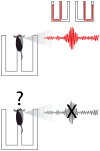Hippocampal-cortical interaction in decision making
- PMID: 24530374
- PMCID: PMC4133322
- DOI: 10.1016/j.nlm.2014.02.002
Hippocampal-cortical interaction in decision making
Abstract
When making a decision it is often necessary to consider the available alternatives in order to choose the most appropriate option. This deliberative process, where the pros and cons of each option are considered, relies on memories of past actions and outcomes. The hippocampus and prefrontal cortex are required for memory encoding, memory retrieval and decision making, but it is unclear how these areas support deliberation. Here we examine the potential neural substrates of these processes in the rat. The rat is a powerful model to investigate the network mechanisms underlying deliberation in the mammalian brain given the anatomical and functional conservation of its hippocampus and prefrontal cortex to other mammalian systems. Importantly, it is amenable to large scale neural recording while performing laboratory tasks that exploit its natural decision-making behavior. Focusing on findings in the rat, we discuss how hippocampal-cortical interactions could provide a neural substrate for deliberative decision making.
Keywords: Decision making; Deliberation; Hippocampus; Memory; Prefrontal cortex; Sharp-wave ripples.
Copyright © 2014 Elsevier Inc. All rights reserved.
Figures



References
-
- Addis DR, Moscovitch M, McAndrews MP. Consequences of hippocampal damage across the autobiographical memory network in left temporal lobe epilepsy. Brain. 2007;130:2327–2342. - PubMed
-
- Benchenane K, Peyrache A, Khamassi M, Tierney PL, Gioanni Y, Battaglia FP, Wiener SI. Coherent theta oscillations and reorganization of spike timing in the hippocampal- prefrontal network upon learning. Neuron. 2010;66:921–936. - PubMed
-
- Buckner RL. The role of the hippocampus in prediction and imagination. AnnuRevPsychol. 2010;61:27–28. - PubMed
-
- Buzsaki G. Hippocampal sharp waves: their origin and significance. Brain Res. 1986;398:242–252. - PubMed
Publication types
MeSH terms
Grants and funding
LinkOut - more resources
Full Text Sources
Other Literature Sources
Medical
Miscellaneous

